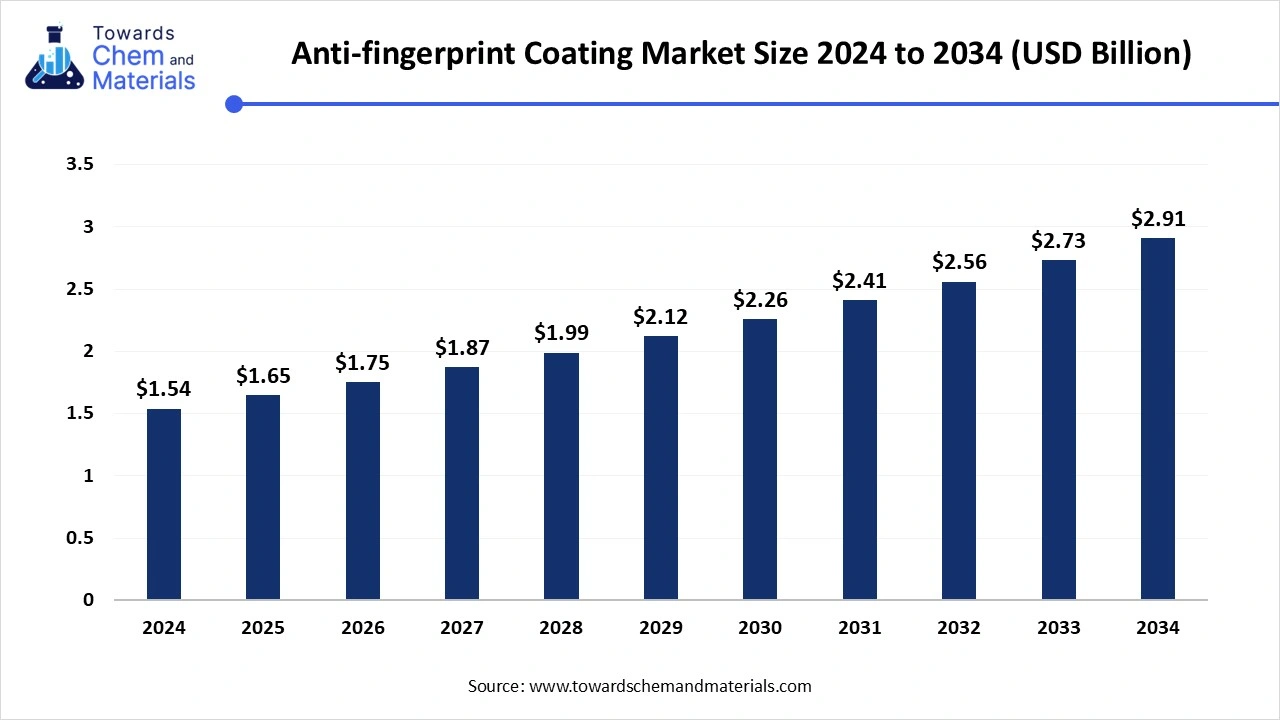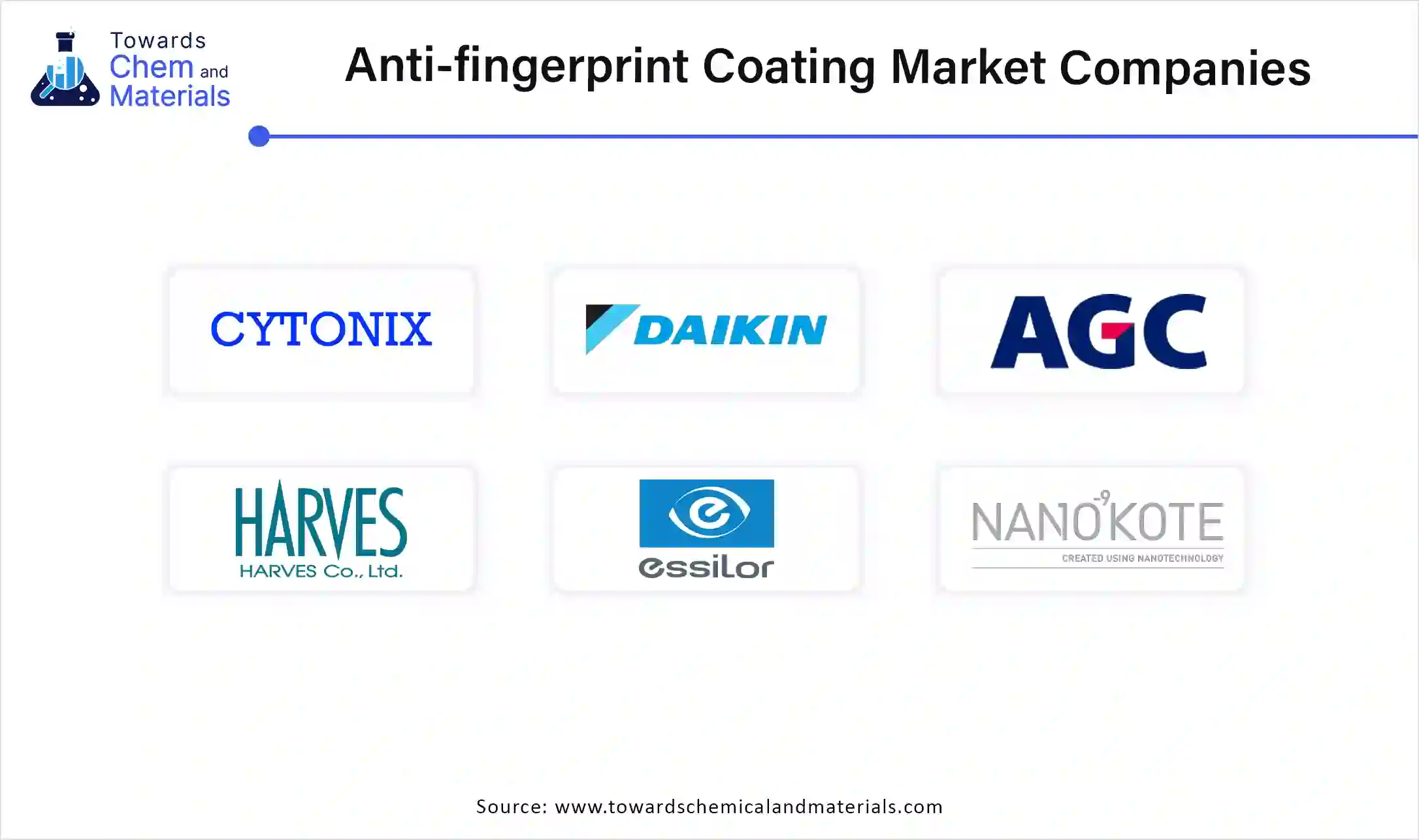April 2025
Market insights predict the global anti-fingerprint coating market industry will increase from USD 1.54 billion in 2024 to USD 2.91 billion by 2034, achieving a CAGR of 6.54%. Rising consumer demand in sectors like electronics, automotive, consumer goods, and construction & building for clean and smudge-free aesthetics drives growth of the market.

Anti-fingerprint coating is a type of very thin coating applied to surfaces like glass, metals, and plastic to protect them from fingerprints, dirt, smudges, and oil. They give aesthetic & presentable looks to the product and enhance the touch experiences of the consumer. For instance, in smartphones, it is applied to touchscreen glass to minimize smudging and enhance the look. These coatings consist of oil & water-resistant properties; due to this, it is very easy to clean. The rising demand for touchscreen devices increases the demand for anti-fingerprint coating due to this market is growing.
Rising usage of electronic devices like smartphones, smartwatches, tablets, laptops, wearables, and many more are enhancing the growth of the market. This coating is applied to electronic devices to prevent them from smudging, and it enhances the product's look. These coatings are applied to the touchscreens of devices to improve visibility and create an aesthetic look. Anti-fingerprint coating to prevent sticking of oil & water particles on the screen. They reduce the maintenance cost of the product and improve user experience. On larger displays, fingerprints and smudges are more visible, and this issue is resolved using anti-fingerprint coatings.
| Report Attributes | Details |
| Market size value in 2025 | USD 1.65 Billion |
| Expected size in 2034 | USD 2.91Billion |
| Growth Rate | CAGR of 6.54% from 2025 to 2034 |
| Base year of estimation | 2024 |
| Forecast Period | 2025-2034 |
| Segment Covered | By Type,Technology,Application,Region |
| Dominant Region | North America |
| Key Companies Profile | AGC Chemicals Europe, Ltd., CYTONIX, DAIKIN INDUSTRIES, Ltd., ESSILOR OF AMERICA, INC., HARVES Co., Ltd., Izovac, Leader Optronics Technology Co.,LTD, NAGASE & CO., LTD., Nanokote; NanoSlic Smart Coatings, Natoco Co.,Ltd., Nippon Paint Surf Chemicals Co., Ltd., PPG Industries, Inc., Sumitomo Chemical Co., Ltd., Taiwanfluoro Technology, Plasmatreat GmbH, Kriya Materials, Janos Tech., Carl Zeiss Limited, and Bühler AG |
The anti-fingerprint coating is used in the automotive industry to maintain a clean and high-quality appearance. They are widely used in touchscreens and displays of cars to improve clarity and minimize driver distraction. Anti-fingerprint coatings are used in door panels, console surfaces, and other parts to create a pleasant environment. The anti-fingerprint coating material is used to enhance the durability of exterior components such as metallic or glass material.
Manufacturers use these materials on wheels and trims to make them easier to clean. Applying these materials on cars reduces maintenance costs, saves car owners time, and extends the lifespan of the coated surface. This keeps the vehicle well-maintained for a long time due to this higher resale value that can get to the consumer or company. The growing urbanization and busy lifestyle increase the demand for premium vehicles that require less time for maintenance, creating a strong opportunity for anti-fingerprint coatings market.
Despite several advantages of anti-fingerprint coatings in various sectors, fluctuating prices restrict the growth of the market. The requirement of specialized materials and complex processes increases the cost of manufacturing. The use of advanced materials like nanomaterials and fluoropolymers is expensive.
On complex shapes, applying anti-fingerprint coatings needs specific equipment and skilled labor that increases cost. Checking the durability and performance of coatings requires extensive testing that adds to the overall cost. The limited availability and rising demand from various industries like electronics, automotive, and many more increases the prices. Due to all these factors, manufacturing costs increase, and this is the leading factor to restrain the growth of the market.
North America dominated the anti-fingerprint coating market in 2024. The rising demand for consumer goods products like spectacles, sunglasses, smart devices, and more drives the growth of the market in the region. Rising consumer awareness regarding technologies and advantages of anti-fingerprint coatings are responsible for the growth of the market. The growing need for vision correction and the changing lifestyles of consumers demand anti-fingerprint coated products. Technological advancement in industrial sectors like automotive, construction, consumer goods, and many more fuels the growth of the market in the region.

Europe is observed to grow at a notable rate during the forecast period. The growing civilization and expansion of the electronics industry drive the growth of the market. The growing demand for clean and maintained surfaces in the public sector, buildings, and transportation fuels market growth in the region. The rising need for smartphones, tablets, smartwatches, and other devices in daily life demands anti-fingerprint coating to preserve appearance. Furthermore, in the healthcare and food processing industries, rising awareness about hygiene and cleanliness drives the growth of the market.
Asia Pacific is seen to witness a considerable share during the forecast period. The strong manufacturing base and growth in the electronic sector in the region help in the growth of the market. Rising population and increased focus on enhancing consumer experience fuels the growth of the market region. Sectors like consumer goods, construction & building, automotive, and electronics demand anti-fingerprint coating and drive the growth of the market.
China holds the largest market share of anti-fingerprint coating. The growing glass production and strong electronics industry drive the market growth in the region. The rising population in the region increases the demand for consumer goods and this fuels the growth of market.
The oleophobic segment dominated the anti-fingerprint coating market. The property of repelling oil and grease and lower need of frequent cleaning drive the growth of the market. They prevent scratches and damage by lowering friction between surfaces and oil. Additionally, it prevents fingerprints from smearing & smudging, and its self-cleaning ability drives the market's growth.
The hydrophobic segment expects a significant growth in the market during the forecast period.
The rising application of hydrophobic coatings in electronics, automotive, and optical industries to enhance durability and performance drives the growth of the market. These coatings are useful in touchscreen devices like smartphones, tablets, and smart watches to reduce adhesion of dirt, oil, and other contaminants. Furthermore, growing applications of the hydrophobic segment in building & construction, medical devices, the textile industry, and consumer goods propel the growth of the market.
The vacuum deposition segment dominated the anti-fingerprint coating market in 2024. The ability to create a very thin, uniform, and durable layer to minimize fingerprint smudging and easy cleaning methods drives the growth of the market. To acquire specific anti-fingerprint properties, precise control of thickness and composition is required. The oleophobic and hydrophobic coatings are applied on glass through a vacuum deposition process that drives the growth of the market.
The sol-gel segment is the significantly growing market during the forecast period. The simplicity, versatility, and cost-effectiveness help in the growth of the market. This process allows synthesis of inorganic & organic hybrid material that helps in manufacturing anti-fingerprint coatings. High durability, scratch-resistance, and aesthetic appeal drive the growth of the market.
The consumer goods segment dominated the anti-fingerprint coating market in 2024. Growing awareness regarding hygiene and cleanliness demands for products that are easy to clean drives growth of the market. The growing demand for touch-enabled devices and surfaces in various sectors fuels the market growth. It helps to create and maintain an aesthetic and professional look on consumer goods products. Rising demand to enhance aesthetics, improve touch sensitivity, reduce maintenance cost, improve optical performance, and enhance visibility drives the growth of the market.
Building and construction expects a significant growth in the market during the forecast period. The growing urbanization raises demand for glass buildings, and aesthetic appeals drive the growth of the market. It is widely used in windows, doors, and facades to maintain cleanliness. Construction materials like stainless steel, polymers, and glass use anti-fingerprint coating to enhance durability and longevity, driving the growth of the market.

April 2025
April 2025
April 2025
April 2025